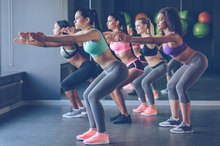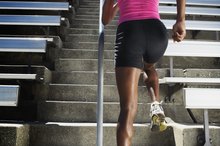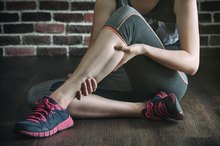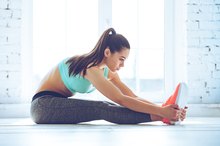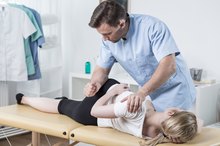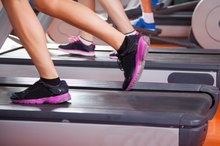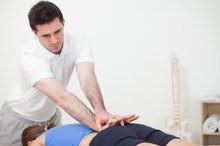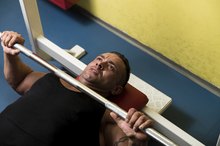Muscles Used in Hip Extension
Hip extension is the backward movement of your thigh and you do it multiple times every day. Muscles that perform hip extension are active when you stand up from a chair, walk, run, jump, roll over and climb stairs. The main muscles used in hip extension are your gluteus maximus and hamstrings.
These muscles also play an important role in maintaining proper posture. Tightness or weakness can develop in them, particularly if you spend a lot of time sitting during the day.
Read More: Men's Hip Exercises
Gluteus Maximus
The gluteus maximus is the main muscle that performs hip extension. It's the largest muscle in your lower body and makes up the rounded shape of your buttocks. It connects your tailbone to your thigh bone, and one of its main functions is to help you stand upright. When your heel hits the ground as you walk, the gluteus maximus also helps stop your body from continuing forward by stopping the hip from flexing.
- The gluteus maximus is the main muscle that performs hip extension.
- It connects your tailbone to your thigh bone, and one of its main functions is to help you stand upright.
Hamstrings
Daily Function of Gluteal Muscles
Learn More
Three muscles called the semitendinosus, semimembranosus and biceps femoris make up your hamstrings. These muscles run along the back of your thighs and are easily injured or strained. They run from your pelvis to the back of your knees and together work to stabilize the hip joint. The hamstrings are the primary muscles that perform hip extension during normal walking.
In addition to hip extension, the hamstrings also bend your knees. These muscles propel your body forward and increase your walking speed.
Read More: Hip Tendinitis and Running
- Three muscles called the semitendinosus, semimembranosus and biceps femoris make up your hamstrings.
- They run from your pelvis to the back of your knees and together work to stabilize the hip joint.
Training for Hip Extension
Moves such as squats, deadlifts, step-ups, leg curls and donkey kicks train the muscles used in leg extension. Include these exercises in your lower body workouts to become stronger at movements that use hip extension -- such as running or jumping. Most athletes benefit from training these muscles.
Even if you aren't aiming to run a marathon or hit the track for a long jump, you'd be wise to work your glutes and hamstrings. Tightness, weakness and inactivity of these muscles can cause pain in your lower back as it compensates for poor glute and hamstring function. Working the muscles at least two times a week with just one set of eight to 12 reps with two or three of the aforementioned exercises does a lot to restore balance and prevent injury.
- Moves such as squats, deadlifts, step-ups, leg curls and donkey kicks train the muscles used in leg extension.
- Include these exercises in your lower body workouts to become stronger at movements that use hip extension -- such as running or jumping.
Related Articles
References
- Wheeless' Textbook of Orthopaedics: Gluteus Maximus
- Wheeless' Textbook of Orthopaedics: Semitendinosus
- Wheeless' Textbook of Orthopaedics: Biceps Femoris
- Wheeless' Textbook of Orthopaedics: Semimembranous
- Contreras BM, Cronin JB, Schoenfeld BJ, Nates RJ, Sonmez GT. Are all hip extension exercises created equal?. Strength Cond J. 2013;35(2):17-22. doi:10.1519/SSC.0b013e318289fffd
- Neumann DA. Kinesiology of the hip:A focus on muscular actions. J Orthop Sport Phys. 2010;40(2):82-94. doi:10.2519/jospt.2010.3025
- Arab AM, Nourbakhsh MR. Hamstring muscle length and lumbar lordosis in subjects with different lifestyle and work setting: comparison between individuals with and without chronic low back pain. J Back Musculoskelet Rehabil. 2014;27(1):63–70. doi:10.3233/BMR-130420
- Eliks M, Zgorzalewicz-Stachowiak M, Zeńczak-Praga K. Application of Pilates-based exercises in the treatment of chronic non-specific low back pain: State of the art. Postgrad Med J. 2019;95:41-45. doi:10.1136/postgradmedj-2018-135920
Writer Bio
Aubrey Bailey has been writing health-related articles since 2009. Her articles have appeared in ADVANCE for Physical Therapy & Rehab Medicine. She holds a Bachelor of Science in physical therapy and Bachelor of Arts in psychology from the University at Buffalo, as well as a post-professional Doctor of Physical Therapy from Utica College. Dr. Bailey is also a certified hand therapist.
